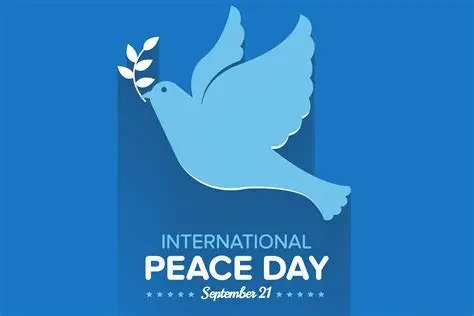International Day of Peace: A Global Call for Unity and Non-Violence

Have you ever paused to imagine a world where, even for just one day, every person focused on peace? A day when individuals reflected on their role in creating harmony, communities came together in unity, and nations set aside their differences. This vision comes to life each year on September 21, when the world observes the International Day of Peace, a day dedicated to strengthening the ideals of peace and reminding us that building a better world begins with collective action.
Theme of International Day of Peace
The theme for this year’s International Day of Peace is “Act Now for a Peaceful World.” This theme emphasizes that it is imperative for everyone to take proactive steps to mobilize for peace during a period of instability, turmoil, and uncertainty.
There is a role for everyone, from students in schools around the world to community members and peacekeepers on the front lines of conflict. We must practice respect, speak out against hate, violence, discrimination, and inequality, and celebrate the diversity of the world around us.
History of the International Day of Peace
The International Day of Peace, also known as World Peace Day, was established by the United Nations General Assembly in 1981. At first, it was observed on the third Tuesday of September, coinciding with the opening of the UN General Assembly session.
Two decades later, in 2001, the Assembly unanimously declared September 21st as the fixed and permanent date, giving the world a dedicated day each year to reflect on and promote peace.
The idea for this day was introduced by Costa Rica, a nation that had abolished its military in 1948 and become a global symbol of peace. By presenting the legislation to create this day, Costa Rica reminded the world that true security is found not in weapons, but in cooperation, dialogue, and respect for humanity.
To mark the occasion, the UN Peace Bell was rededicated in 2013 as a symbol of hope and remembrance. Cast from coins donated by children from every continent, the bell carries the inscription: “Long live absolute world peace.” Every ring of the bell serves as a reminder of the devastating cost of war and the shared responsibility to prevent it.
Over the years, the meaning of the day has grown beyond commemoration. It now calls for a 24-hour global ceasefire, urging nations and groups everywhere to pause conflict and embrace non-violence.
Though ambitious, this bold goal underscores the heart of the International Day of Peace: showing that dialogue and understanding are always stronger paths forward than confrontation and division.
Significance of the International Day of Peace
Peace is a state of tranquility where people are free from disturbance, fear, and harm. Achieving peace requires understanding, cooperation, and the willingness to resolve problems together rather than through conflict. The International Day of Peace provides the environment needed for such peaceful resolutions, reminding the world that violence only leads to suffering.
This day seeks to promote acceptance and inclusion by encouraging all people to commit to non-violence. It aims to break down differences and build a culture of peace across nations and communities.
In a world often harmed by terrorism, hatred, violence, and military conflicts, the observance serves not only as a call for calm but also as a way to reduce the immense human and economic costs of war.
The United Nations has urged all member states to observe a 24-hour ceasefire and a day of non-violence on September 21.
This commitment allows those suffering from war and conflict to experience, even briefly, a sense of safety and relief.
By pausing violence for a day, the world demonstrates that peace is possible and reminds us of the importance of dialogue, compassion, and unity in creating a more secure future for all.
Ideas for the International Day of Peace Celebration
Honoring the International Day of Peace provides an opportunity for people, groups, and countries to actively promote a culture of peace rather than merely recognizing its existence. Participation can take many forms, from reflection to community service and global awareness campaigns.
- Plan a neighborhood peace walk or rally, or take part in one.
- Promote understanding and celebrate diversity by hosting a multicultural dinner or event.
- Create artwork with a peace theme or take part in a mural project in your neighborhood.
- Volunteer with a local group that advocates for social justice and peace.
- Take part in a personal act of forgiveness or reconciliation.
Education as a Tool for Peace
On the International Day of Peace, the importance of education in creating a culture of harmony is frequently highlighted.
Education is an effective means of fostering friendship, tolerance, and understanding among nations, races, and religions. Many educational institutions use this day to teach conflict resolution techniques, encourage intercultural understanding, and implement peace education initiatives.
Universities and educational institutions often host special lectures, workshops, and seminars on subjects linked to peace.
Discussions about human rights, international challenges, and the value of diplomatic conflict resolution are central to these gatherings. In order to create a more secure and peaceful society, education is essential in shaping a generation that values peace.
Furthermore, this day is often used by the UN to emphasize the value of teaching students about global citizenship, which encourages them to take an active role in confronting and resolving global issues.
This educational approach promotes a more sustainable and peaceful world by encouraging a sense of humanity and connection to a larger community.
The Role of Technology in Promoting Peace
Technology has become a powerful instrument in recent years for fostering international understanding and peace.
Global connections, experience sharing, and relationship building are now easier than ever thanks to social media platforms and digital communication tools. This interconnectedness can help break down barriers and create a global network of peace activists.
To raise awareness of the International Day of Peace and encourage participation in peace-building initiatives, many groups use technology. In order to foster empathy and understanding, virtual reality experiences that allow users to “walk in someone else’s shoes” are being deployed.
Global discussions and cooperation on peace projects are made possible by online platforms, which allow individuals from different backgrounds to work together on shared goals.
Technology is also being employed in peacekeeping operations, early warning systems, and conflict monitoring. Organizations are using data analytics and artificial intelligence to identify conflict hotspots and design targeted interventions.
These technological advancements are opening up new opportunities for preserving peace and finding creative solutions to disputes.
Conclusion
As we commemorate the International Day of Peace, we are reminded that true peace is more than the absence of war; it is the presence of justice, equality, compassion, and harmony. This day calls on us to recognize our shared responsibility in shaping a more peaceful world and to transform our hopes into meaningful action in our everyday lives.
Each of us, no matter how small our role may seem, has the power to make a difference. Through education, technology, dialogue, and community engagement, we can plant the seeds of peace and nurture them with kindness and understanding.
Let this day inspire us to work together for a future where conflicts are resolved with words instead of weapons, and where every child can grow up in a world free from violence.





